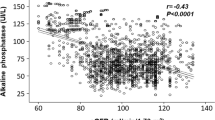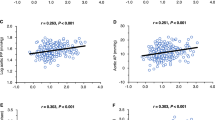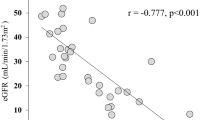Abstract
In this study the role of circulating transforming growth factor β1 (TGFβ1) on progression of renal hypertensive disease has been investigated. Fifty consecutive outpatients with essential hypertension were enrolled and divided into three groups, according to their urinary albumin excretion (UAE). Group A comprised 10 hypertensives with UAE ⩽20 mg/24 h (normoalbuminuric group); Group B included 21 hypertensives with UAE > 20 < 300 mg/24 h (microalbuminuric group); Group C encompassed 19 hypertensives with UAE ⩾ 300 mg/24 h (proteinuric group). In all patients UAE by immunonephelometric assay, circulating TGFβ1 by a solid phase specific sandwich ELISA technique, BUN and creatinine by routine laboratory methods were determined. In addition, left ventricular telediastolic internal diameter, interventricular septum diastolic (IVSTd), posterior wall thickness, total and normalised to height2.7 left ventricular mass, relative wall thickness and left ventricular ejection fraction by M-B Mode echocardiography were calculated. Our results indicated that TGFβ1 levels were significantly (P < 0.05) higher in Group B and C than Group A and in Group C than Group B. In addition IVSTd values were significantly (P < 0.05) higher in both Group B and C than Group A. An evident, but not significant, higher prevalence of subjects with left ventricular hypertrophy were observed in Group C as compared with other groups. In all hypertensive subjects TGFβ1 correlated directly with UAE (P < 0.0001) but not with BMI, LVM/h2.7 and mean blood pressure. Our data indicated that TGFβ1 might be considered a useful marker to evaluate the severity and progression of hypertensive renal disease. Additional long-term clinical data are needed to evaluate whether inhibition of TGFβ1 system may prolong the time to the ESRD in hypertensive patients.
This is a preview of subscription content, access via your institution
Access options
Subscribe to this journal
Receive 12 digital issues and online access to articles
$119.00 per year
only $9.92 per issue
Buy this article
- Purchase on Springer Link
- Instant access to full article PDF
Prices may be subject to local taxes which are calculated during checkout

Similar content being viewed by others
References
Kannel WB . Blood pressure as cardiovascular risk factor JAMA 1996 275: 1571–1576
Petty HM Jr et al. Early predictors of 15-year end-stage-renal disease in hypertensivepatients Hypertension 1995 25: 587–594
Lindeman RD, Tobin JD, Shock NW . Association between blood pressure and the rate of decline in renal function with age Kidney Int 1984 26: 861–868
Weinstock W, Keane WF . Proteinuria and cardiovascular disease Am J Kidney Dis 2001 38 (Suppl 1): S8–S13
Roberts AM, Sporn MB . Transforming growth factor β Adv Cancer Res 1988 51: 107–145
Roberts AM, Mc Cune BK, Sporn MB . TGF-β: regulation of extracellular matrix Kidney Int 1992 41: 557–559
Border WA, Nobel NA . Transforming growth factor-β in tissue fibrosis N Engl J Med 1994 331: 1286–1292
Bottinger EP, Letterio JJ, Roberts AB . Biology of TGF-β in knockout and transgenic mouse models Kidney Int 1997 51: 1255–1360
Laviades C, Varo N, Diez J . Transforming growth factor β in hypertensives with cardiorenal damage Hypertension 2000 36: 517–522
Li B et al. TGFβ1 DNA polymorphisms, protein levels, and blood pressure Hypertension 1999 33: 271–275
Suthanthiran M et al. Transforming growth factor β1 hyperexpression in African-American hypertensives: a novel mediator of hypertension and/or target organ damage Proc Natl Acad Sci USA 2000 97: 3479–3484
Derhaschnig U et al. Increase levels of transforming growth factor β1 in essential hypertension Am J Hypertens 2001 14 (Suppl 1): A169–A170
Joint National Committee on Prevention, Detection, Evaluation, and Treatment of High Blood Pressure. The Sixth Report of the Joint National Committee on Prevention, Detection, Evaluation, and Treatment of High Blood Pressure Arch Intern Med 1997 157: 2413–2446
Khanna A, Li B, Stenzel KH, Suthanthiran M . Regulation of new DNA synthesis in mammalian cells by ciclosporine: demonstration of a transforming growth β factor dependent mechanism of inhibition of cell growth Transplantation 1994 57: 577–582
De Simone G et al. Effect of growth on variability of left ventricular mass: assessment of allometric signals in adults and children and their capacity to predict cardiovascular risk J Am Coll Cardiol 1995 25: 1056–1062
De Simone G et al. Left ventricular mass and body size in normotensive children and adults: assessment of allometric relations and impact of overweight J Am Coll Cardiol 1992 20: 1251–1260
De Simone G et al. Relation of obesity and gender to left ventricular hypertrophy in normotensive and hypertensive adults Hypertension 1994 23: 600–606
Urbina E et al. Effects of body size, ponderosity and blood pressure on left ventricular growth in children and young adults in the Bogalusa Heart Study Circulation 1995 25: 1056–1062
Wyatt HI et al. Cross sectional echocardiography III. Analysis of mathematic models for quantifying volume of symmetric and asymmetric left ventricular Am Heart J 1980 100: 821–828
Corrao S, Scaglione R, Arnone S, Licata G . Left ventricular diastolic filling alterations in subjects with mitral valve prolapse: a doppler echocardiography study Eur Heart J 1993 14: 369–372
Watchell K et al. Impact of different partition values on prevalences of left ventricular hypertrophy and concentric geometry in a large hypertensive population: the LIFE study Hypertension 2000 35: 6–12
Ketteler M, Noble NA, Border WA . Increased expression of transforming growth factor beta in renal disease Curr Opin Nephrol Hyperters 1994 3: 446–452
Ziyadeh FN et al. Long-term prevention of renal insufficiency, excess matrix gene expression, and glomerular mesangial matrix expansion by treatment with monoclonal antitransforming growth factor-beta antibody in db/db diabetic mice Proc Natl Acad Sci USA 2000 97: 8015–8020
Dahly AJ et al. Chronic anti TGFβ Ab therapy reduces proteinuria and renal injury in hypertensive rats J Am Soc Nephrol 2000 11: 332A
Border WA, Nobel NA . Interactions of transforming growth factor-β and angiotensin II in renal fibrosis Hypertension 1998 3: 181–188
Remuzzi G, Bertani T . Pathophysiology of progressive nephropathies N Engl J Med 1998 339: 1448–1456
Sharma K et al. Captopril-induced reduction of serum levels of transforming growth factor-β correlates with long term renoprotection in insulin-dependent diabeticpatients Am J Kidney Dis 1999 34: 818–823
Gyu-Tae Shin et al. ACE inhibitors attenuate expression of renal transforming growth factor-β1 in humans Am J Kidney Dis 2000 36: 894–902
Pinto YM et al. Reduction in left ventricular messanger RNA for transforming growth factor β1 attenuates left ventricular fibrosis and improves survival without lowering blood pressure in the hypertensive TGR (mRen2) 27 rat Hypertension 2000 36: 747–754
Noble NA, Border WA . Angiotensin II in renal fibrosis: should TGFβ rather than blood pressure be the therapeutic target? Semin Nephrol 1997 17: 445–466
Author information
Authors and Affiliations
Corresponding author
Rights and permissions
About this article
Cite this article
Scaglione, R., Argano, C., Parrinello, G. et al. Relationship between transforming growth factor β1 and progression of hypertensive renal disease. J Hum Hypertens 16, 641–645 (2002). https://doi.org/10.1038/sj.jhh.1001465
Received:
Revised:
Accepted:
Published:
Issue Date:
DOI: https://doi.org/10.1038/sj.jhh.1001465



